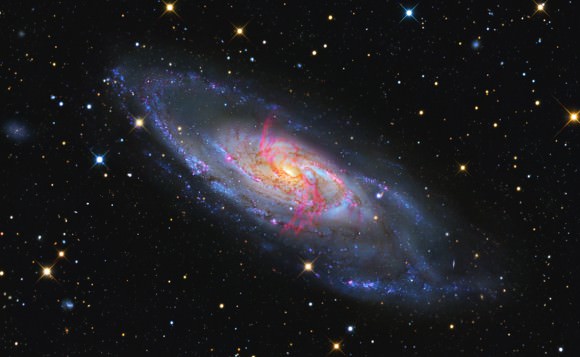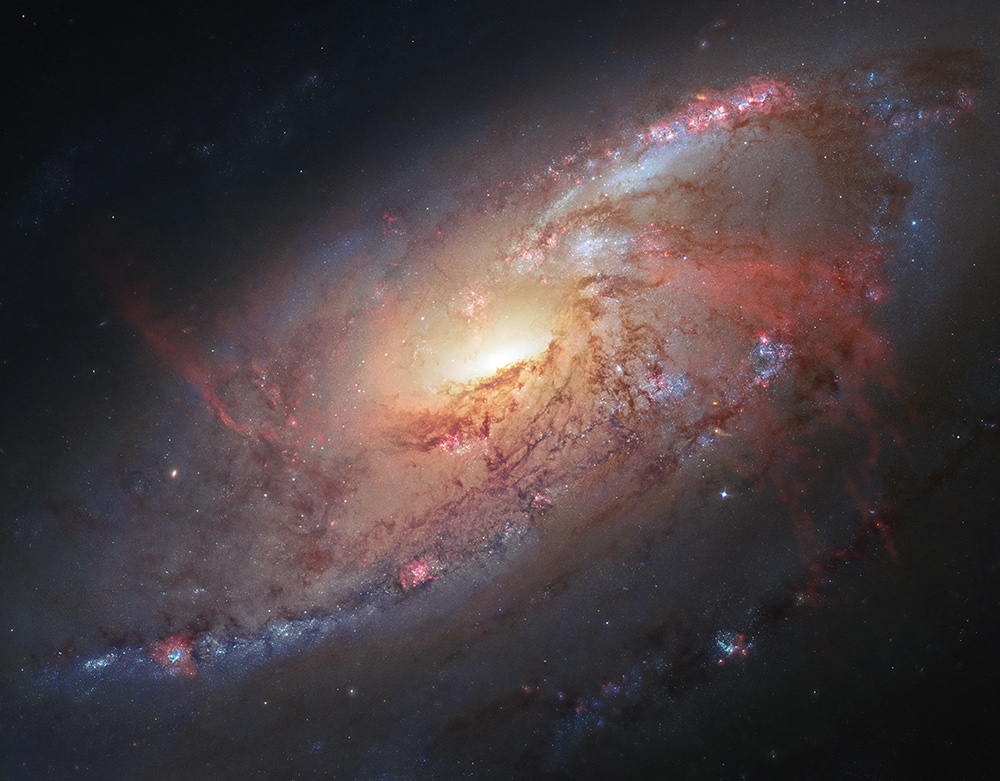Nearly four million light years away in the direction of the constellation of Canes Venatici, a visage of creation awaited to be revealed. Now, thanks to the teamwork of the astronomical image processors at the Space Telescope Science Institute in Baltimore, Maryland, and world-renowned astrophotographers Robert Gendler and Jay GaBany, we’re able to see combined Hubble Space Telescope data with ground-based telescope imaging. Let’s look deep into spiral galaxy, Messier 106.
This wasn’t an overnight imaging project. “A few months ago the Hubble Heritage Team contacted me and asked if I’d be interested in making a large format image of M106 from the available data on the Hubble Legacy Archive,” says Gendler. “I agreed and went to work downloading a large number of data sets from the HLA. I realized this would be a massive project. The image would be a mosaic of more than 30 panels and would incorporate both wideband and narrowband data sets.”
With the cooperation of Jay GaBany, they combined their own observations/images of this magnificent structure and compiled it with Hubble data – filling in areas where no data was available. The resulting image is a portrait of such depth and beauty that it’s almost like looking into the eyes of creation itself.
Be swept away…
If you’re drawn to the core of Messier 106, there’s good reason. It isn’t just an ordinary spiral galaxy, it’s one that has a peculiar jet flow which can be detected in radio and in H-alpha wavelengths. “Due to the special geometry of the galaxy, the jets emerge from the nuclear region through the galactic disk,” says Marita Krause (et al). “Also the distribution of molecular gas looks different from that in other spiral galaxies.” It is just this difference that makes NGC 4258 (M106) stand out a bit from the crowd and so worthy of further processing. According to new modeling techniques the “concentration of CO along the ridges is due to interaction of the rotating gas clouds with the jet’s magnetic field by ambipolar diffusion. This magnetic interaction is thought to increase the time the molecular clouds reside near the jet thus leading to the quasi-static CO ridge.”
Knowing those jets are present and the hunger to reveal them through imaging became the driving force for R. Jay GaBany. “Since the early 1960s, M106, also known as NGC 4258, has been known to exhibit an extra pair of arms, located between the spiral arms comprised of stars, dust and gas. But an explanation for their existence remained elusive until earlier in this decade,” says Jay. “My contribution to the image came from my 2010 image of M-106 that revealed the full extent of its amazing jets. My image include 22 hours of white light exposures through clear, red, blue and green filters plus and other 15 hours of imaging through a 6nm narrow band h-alpha filter.”

“Seen in the light emitted by hydrogen molecules when they become ionized, these arms display an artificial red hue to make them visible in the image I produced. The extra arms are now believed to be caused by high energy jets emanating from an active 40 million solar mass super-massive black hole menacing the galaxy’s center,” explains GaBany. “Because the jets are tilted at a low inclination they pierce the disk and surrounding halo of this galaxy. So, as the jets pass through regions of gas, they create an expanding cocoon of shock waves that heats the surrounding material causing it to release radiation in optical wavelengths. The curvature and fraying seen at their extremities represents previous trajectories of the jet due to past precession. Precession is a change in the orientation of the rotation axis of a spinning object. For example, the wobble of a spinning top.”
Yet, that’s not all. This low luminosity Seyfert II galaxy is also hosting a maser – its warped disk of water molecules discovered in 1994. Through radio observations, M106 became the first of its kind to show the exact location of the core of an AGN (active galactic nucleus). According to a study done by JR Herrnstein (et al): “NGC 4258 is an exceptional laboratory for the study of AGN accretion processes. The nuclear maser reveals details about the kinematics and structure of the accretion disk on subparsec scales and permits the determination of the central mass with great precision.”
And there is still more…
Deep inside lurks that known supermassive black hole – one that’s extremely active and produces bright microwave radiation. But, don’t stop there. Ordinarily a spiral galaxy has two arms, but M106 has double. These ethereal “extras” can be seen as faint ribbons of gas at optical wavelengths, but become solidified when viewed in x-ray and radio. Here the structure is formed in hot gas rather than stars. While this process was once a mystery to astronomers, new information suggests they may arise from the black hole activity, making them a unique artifact. What could cause it? These “extra arms” could be the result of the violent turbulence at the core – where gases are superheated and interact with their denser counterparts causing them to illuminate. At the perimeter of the galactic structure, the gases are more loose and the arching formation could be the product of the movement of jet activity.
“One goal I had early on was to feature the well known ‘anomalous arms’ of M106,” said Gendler. “This feature, peculiar to M106, is thought to arise from superheated gases, energized by accretion of matter into the galaxy’s massive black hole. The anomalous arms emit light in the visual spectrum around 656nm (hydrogen alpha) and I found a fair amount of hydrogen alpha data sets for the arms in the HLA.”
Gendler was responsible for all the image assembly and processing. “Assembling the image required over two months,” he said. “The quality of the data ranged from good to very poor. The central galaxy had sufficient color data but away from the center the Hubble data was incomplete and in some areas did not exist. I then decided to use ground based data from my own image and Jay GaBany’s image of M106 to fill in areas of missing or incomplete Hubble data. I also used ground based data to boost the signal of the outer areas of the galaxy as the Hubble data was sparse and of short exposure for the more remote areas of the galaxy.”
All in all, Messier 106 is a galaxy that deserves attention – attention and a loving touch given by two of the very best amateur astronomers and dedicated astrophotographers to be found.
Original News Source: HubbleSite Image Release.


Incredible is the distances between gal’x’s. Space-Time is a fabric some 14 billion light years wide/long etc.. .. We must learn how to sculpture its fabric to reveal the dimensions with-in it. I believe in a creator and His sculpturing of this universe. Dark matter/energy will be known someday. We are infants barely teething in this time/age of earth & universe. In the year 4513. Can you imagine the inventions? WOW. God Bless all….ME
El universo es dinámico, al igual que Su Creador que es abundante en energía dinámica!
Question: Do galaxies produce super-massive black holes…..or do super-massive black holes produce galaxies?
It isn’t known which direction that happens in, exactly.
However,I like to think of galaxies as the extended accretion disks of black holes. (IE, eventually the accretion disk grows large enough that the disk itself grabs material beyond the easy reach of the black hole, and eventually the extended accretion disk outweighs the central black hole by 2 or 3 orders of magnitude. Then you have a galaxy:).
I really like that theory!
Good question.. LATELY there seems to be some evidence black holes come first! But like all theory, depends on which data sets you look at…?
Newly found halo’s of high energy gamma rays on either pole of the Milky Way come to mind here. Gamma rays are formed only by the highest level energy events, like during anti matter annihilation. We have assumed all matter formed shortly after the ‘Big Bang’ and the universe was predisposed toward making matter over anti matter which has ‘settled out’. Well… maybe it’s time to re-evaluate that assumption? How much gumption is there left to chew?
On-going nucleosynthesis seems to fit? Singularities within all black holes? rotating or not? Are we, after all is said and done, mere ‘shadow play’ of larger realities? ACK! Go figure….
HI TAMMY! Welcome Ommm!
Since time would not exist inside the singularity, once the black hole forms it will be there forever and will have always been there.
What about Hawking radiation?
Hawking radiation is emitted at the event horizon.
Well, yes, but what does <a href=”https://en.wikipedia.org/wiki/Hawking_radiation#Black_hole_evaporation”evaporation of black hole” means in this case? Is there “something” left behind? And what about <a href=”https://en.wikipedia.org/wiki/Heat_death_of_the_universe#Black_hole_evaporation”universe heat death” scenario if there are naked singularities still flying around?
I believe the singularities lead to white holes (via wormholes), and since time doesn’t exist there, the white holes are all back at a point 13.772 years before present. Once all matter has been absorbed through singularities in the far distant ‘future’ it will all have been transported back to the beginning (big bang). It is a continuous loop.
I believe that time for all matter (and energy as I understand) to be absorbed by singularities would be like 10^666^666^666 * 3,5. Just imagine that very last photon scattering around hugely expanded universe trying to find its infinity well… 😉 Doesn’t sound like mainstream physics to me (I’m ignorant, though), but I’m sure there is a lot of observational and experimental data to support those theories.
NO, not mainstream. Just a mind exercise I’ve been playing with. Needs a lot of work still. LOL
There is no clear answer to this question. I think the opinion, and unfortunately this does come down to largely opinion, is that black holes were first. They were probably formed from the explosion or supernova like events from early popIII stars. However, there are problems with trying to figure out how these black holes quickly grow from maybe a few 10s or 100s of solar masses into millions or maybe billions of solar mass behemoths within a few hundred million years.
It is hard in a way to get matter into a black hole. For a free black hole without lots of stuff around it you have to shoot a particle pretty directly into it to get it to fall in. Otherwise the particle just goes into an orbit around it. If you do have lots of matter around a black hole, the implosion of this matter is facilitated by friction or hydrodynamic drag effects. However, the heating up of this material tends to force most of the matter away. Think of the spectacular jets of matter flying out from the centers of galaxies is SMBHs.
So there are a range of unanswered astrophysical problems.
LC
do all galaxies rotate counter-clockwise? why?
See this earlier article also by Tammy Plotner:
Are The Galaxies In Our Universe More Right-Handed… Or Left-Handed?
Great article ! One technical comment – I think M106 is twenty four million light years away, not four.